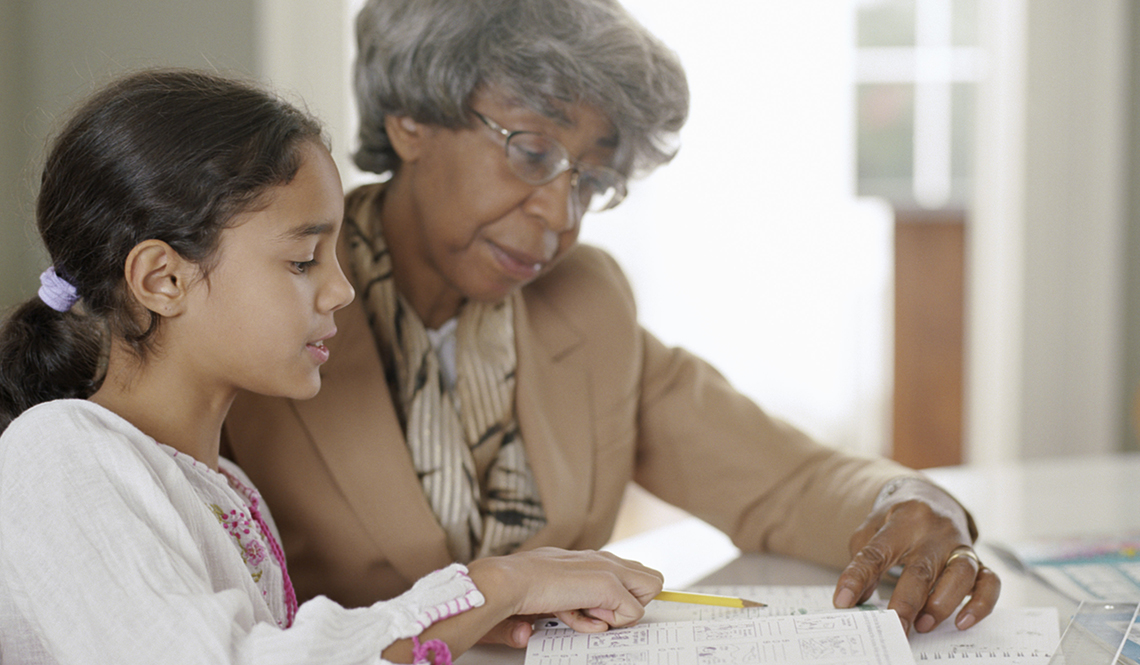As a divorced, single mom, Karen Spencer thought she was done raising children when her son and two daughters grew up and left home. It didn’t work out that way.
About 10 years ago, Spencer’s youngest daughter became suddenly single. She moved back home with her five-year-old son in tow. She stayed for a year while getting a job and back on her feet.
Then Spencer’s other daughter returned home—single, pregnant and on total bedrest on doctor’s orders. Spencer found herself caring for her daughter, driving her to doctor appointments, cooking for her, paying her bills—all, on top of working full time. Then the baby arrived, and there was the challenge of helping to care for a newborn preemie.
“It was super stressful,” Spencer said. “I wondered when things would return to normal.”
Like many of her peers, Spencer did her best to cope in a new world of grandparenting, one that’s in sharp contrast to the idyllic (and perhaps imaginary) image of the stay-at-home grandma living a relaxed and quiet life.
She’s facing pressures that didn’t affect previous generations of grandparents nearly as much: coping with the aftereffects of divorce (both her own and her kids’); providing support for her adult children, who took a long time to become independent; and doing it all while working full time herself.
“With all the changes in society, in families, in social demographics, grandparents are assuming a larger role as a stable force in the family,” said Ling Xu, assistant professor in the School of Social Work at the University of Texas at Arlington. “They really make a significant contribution.”
Spencer is far from alone. She’s one of about 70 million grandparents in the United States—the largest, most active and quite possibly the most involved generation of grandparents ever.
“The baby boom has become the grandparent boom,” according to AARP. “The same boomers who famously doted on their children are now lavishing attention on their grandchildren.”
Blended Families
Many of those grandparents are stepgrandparents, who must navigate the intricacies of blended families. Nearly half of middle-aged and older (50+) couples with children are in stepfamilies (one or both spouses/partners is not the biological or adoptive parent of the other’s child or children). When grandchildren (step or otherwise) enter the picture, the family tree quickly grows complicated.
Joy Miltenberger, 73, and her husband each have three children from previous marriages. Between them, there are 16 grandchildren, ages five to 30. Miltenberger jokingly calls her stepoffspring her “bonus” children and grandchildren.
“It’s more positive than using the word ‘step,’” she said.
Even though the Miltenbergers never blended their family in one household (they married after their children had left home), Miltenberger said she’s learned it’s important to “tread lightly” in her relationship with her bonus children, and that spills over into her relationship with their children.
“You have to know your place,” she said. “You will never take the place of your bonus children’s mother. I do not want to be intrusive.”
Miltenberger adds that the life she’s living as a grandmother bears little resemblance to that of her own grandmother. Both Miltenbergers still work full time, and Joy Miltenberger is helping to care for her mother, who lives independently but has mild dementia.
A record number of Americans today live in three-generation households.
“We thought of our grandparents as quite elderly, but we are still both active,” she said. “There’s no comparison.”
Miltenberger said their bigger challenge as grandparents has been distance. The couple lives in the St. Louis, MO, area; their grandchildren live in Dallas, Los Angeles, San Diego and the Caribbean. The couple tries to find a way to celebrate each grandchild’s first birthday in person, but they’d like to see them more often. Between visits, technology helps keep them connected; they video-chat with the grandkids via FaceTime or Skype, Miltenberger said, but not as often as she’d like, given her busy schedule and the kids’ many activities.
“If the kids were here, we’d be going to their games and to Grandparents Day events at school,” she said. “I don’t know all my grandchildren as well as I’d like.”
Close to Home
While some families work hard to overcome geographic barriers, others find themselves living in very close proximity. A record 64 million Americans live in multigenerational households, according to a 2016 Pew Research Center study, up from 51 million in 2009. About 10 percent of grandparents live with grandchildren, most of them in three-generation households.
About 2.6 million grandparents—roughly 4 percent of all grandparents—are the primary caregivers of their grandchildren. That number is increasing, due to growing problems like opioid and other forms of addiction or mental health issues, and due to the military deployment of women. Grandparents are stepping up when the grandchildren’s parents can’t, or won’t, handle the responsibility. But it can be a real struggle, according to Carole Cox, professor in the Graduate School of Social Service at Fordham University.
“It means your life is changed,” Cox said. “If you’re still working, you might have to stop. If you enjoyed socializing with other seniors, you can’t do that if you have to be home with the children.”
Even when the kids are in school all day, they need care during summer vacations and holidays, plus there are myriad duties, like doctor appointments or driving to and from school and activities.
Full-time grandparents must cope with the loss of independence and freedom at the same time that the children may be struggling with emotional issues, such as insecurity and feeling they’ve been abandoned. When a caregiving grandparent is single—with no strong system of support from a spouse or family member—it’s even harder.
Studies suggest that single grandparents raising grandchildren full time are more vulnerable to poor physical and mental health.
Becoming a grandparent is one of life’s major turning points. There are new lessons to learn.
Grandparents are also dealing with a trend that sociologists have noted: a “longer runway” for the current generation of young adults on the way to independence. As a group, today’s young adults leave home, get full-time jobs and marry at a much later age than previous generations. When these not-yet-independent adults become parents—often, single parents—they turn to their own parents for help with child care and money.
Spencer, now 56, was fiercely independent at an earlier age than her daughters, who moved home as adults.
“Instead of saying, ‘Mom, I need diapers,’ and expecting her to pay, I would’ve wrapped my kids in a towel,” she said.
Ultimately, things did return to normal for Spencer. Today, her three adult children are independent and in happy, stable relationships. Her nine grandchildren, age five months to 16, are doing well too. When her daughter remarries a few months from now, she’ll add two stepgrandchildren to her brood. These days, Spencer’s role as a grandmother is focused on babysitting on weekends, which she relishes. She has no regrets about helping out when she did.
“I don’t think my daughters gave much thought to it at the time, but now they’re so grateful for all that I did, both physically and financially.”
Walking the Line
Becoming a grandparent is a major life turning point, one that involves learning to step back and let the grandchildren’s parents take charge. Even for grandparents who provide regular child care, most experts advise against interfering or enforcing rules that conflict with those of the grandkids’ parents.
“Giving advice is not what you do,” said Cox, who has three grandchildren herself. When the grandparent doesn’t agree with the parents’ rules (unless there’s something that poses a clear danger to the child’s health and safety), “it’s really important that grandparents support the parents,” Cox said. “Otherwise, it’s giving too many mixed messages. Every family has to work that out.”
In response to parenting practices they don’t like, Cox joked that she and her friends have mastered what she calls “the neutral ‘Ohhh’”—the ability to respond without comment.
“If a grandparent starts to interfere or give unsolicited advice, parents are likely to take offense,” she said. “It can be threatening, make the parents feel as if they are not doing a good job and, in the extreme, it can harm relationships.”
Cox encourages grandparents to advise only when asked, “and then to say, ‘What do you think?’”
Financial Challenges
Many grandparents step in to help their grandchildren financially, which poses its own pitfalls. According to the Consumer Financial Protection Bureau (CFPB), the number of people 60 and older carrying student loan debt—either as the primary loan holders or as cosigners—quadrupled from 700,000 to 2.8 million between 2005 and 2015. That figure includes older adults who are carrying their own student debt later into life, but also the growing number of parents and grandparents financing their children’s and grandchildren’s college educations.
“That can be detrimental to the grandparents’ finances, so that they don’t have enough in retirement savings,” said Ted Rossman, an industry analyst for CreditCard.com, a consumer information website. “You can get loans for college, but you can’t get loans for retirement.” He adds that grandparents who overextend themselves financially to help pay for college could end up needing financial support later from children or grandchildren. Rossman’s advice: “It’s nice to be generous. But know what you can actually afford.”
Great-Grandparent Boom
Despite the challenges, today’s grandparents also enjoy many advantages. Overall, they represent the most educated, healthy and active generation of grandparents in history.
And in a growing number of families, grandparents have another layer of support: great-grandparents. No major survey or Census Bureau tabulation provides hard data on the number of great-grandparents living in the United States, but demographers believe that a “great-grandparent boom” is on the horizon as lifespans increase. Ken Wachter, emeritus professor of demography and statistics, University of California, Berkeley, estimates that by 2030, more than 70 percent of eight-year-olds will likely have a living great-grandparent.
Nathan Ivey, 91, doesn’t remember his own grandparents, who had all passed away by the time he was five. But he does remember the exact day and time he and his wife, Dorothy, 96, became great-grandparents: April 26, 2018, at 10:56 pm, when his great-grandson AJ was born.
Although he was involved in his grandchildren’s lives, Ivey said, “I was still employed, and still very busy, when all four of our grandchildren were born.”
Having retired at age 86, Ivey is now on a more relaxed schedule, and he and Dorothy look forward to frequent playdates with AJ, who lives about 15 miles away.
“He has captured our hearts,” he said. “By the time he was five months old, he could recognize us when we would come to see him. That was so exciting.”
Reaping the Rewards
For many, involvement with grandchildren offers a sense of purpose and engagement as well as fun. That may explain why at least one study suggested that those grandparents who provide care occasionally for grandchildren are less vulnerable to dementia.
Grandparenting duties have certainly motivated Fred Frawley, 76, a nearly retired attorney, to stay active and healthy. In 2003, his doctor recommended a hip replacement but advised him to postpone the surgery as long as possible, until he absolutely needed it. That day came in 2008, following the birth of his grandson, Zach.
“As soon as I realized Zach was getting mobile, I went ahead with the surgery,” Frawley said.
Staying physically fit has enabled Frawley and his wife, Sharon, to play a big role in the lives of their two grandchildren, Zach, now 11, and Kate, seven. They pick up the kids from school a couple of days a week, sometimes shuttling them to activities or doctor appointments, or caring for a sick child at home. The couple takes on an even bigger role during the summers, when school is out.
The relationship he shares with his grandchildren is much closer and more involved than the one Frawley remembers with his own grandparents. He and his grandson are both history buffs; Frawley helps the boy research history projects for school.
“We love being involved with the grandchildren,” Frawley said. “We get to send them home at night, and then we sleep very well.”

Freelance writer Mary Jacobs lives in Plano, TX, and covers health and fitness, spirituality, and issues relating to older adults. She writes for the Dallas Morning News, the Senior Voice, Religion News Service and other publications; her work has been honored by the Religion Communicators Council, the Associated Church Press and the American Association of Orthopaedic Surgeons. Visit www.MaryJacobs.com for more.



